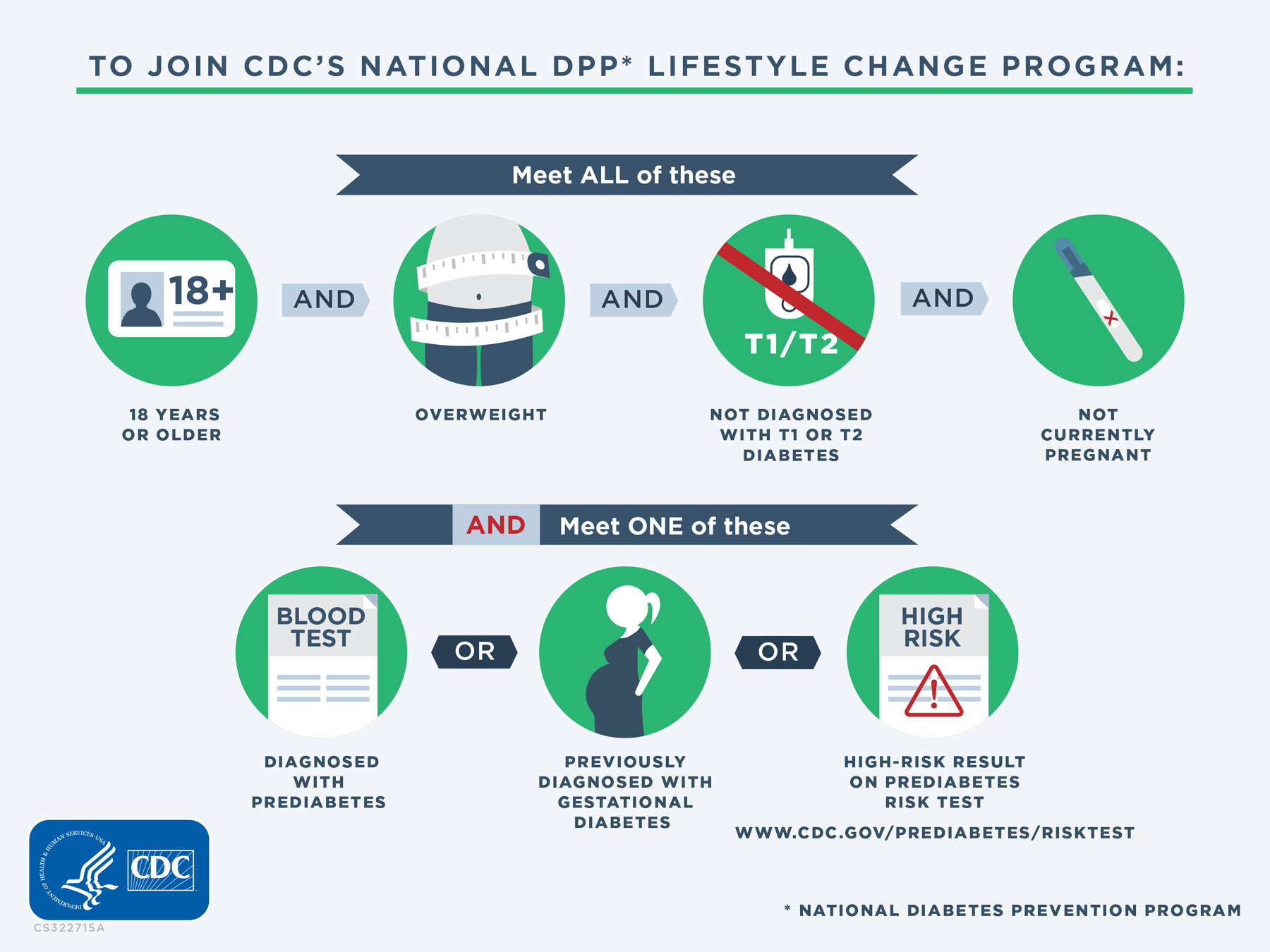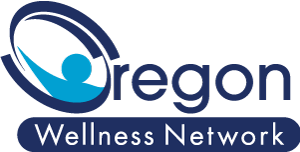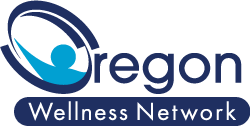1 in 3 adults has prediabetes. Most don’t know it.
Having prediabetes means your blood glucose (sugar) levels are higher than normal—but not high enough to be diagnosed as diabetes. Prediabetes can lead to heart disease, stroke, and type 2 diabetes, the most common form of diabetes. Prediabetes can often be reversed by making the types of changes you can learn about in National DPP.
Take a short quiz to find out if you may have prediabetes:
Frequently Asked Questions
This lifestyle change program is not a fad diet or an exercise class. And it’s not a quick fix. It’s a year-long program focused on long-term changes and lasting results. A year might sound like a long commitment, but learning new habits, gaining new skills, and building confidence takes time. Program participants:
- Get support from a trained coach and a close group of their peers
- Learn to manage stress and overcome challenges
- Discover fun physical activities to do alone or with a group.
- Learn how to make healthy food choices they can enjoy
- Make small lifestyle changes over time
As you begin to eat better and become more active, you’ll notice changes in how you feel, and maybe even in how you look.
Research shows that CDC-recognized lifestyle change program participants who lost 5-7% of their body weight and added 150 minutes of exercise per week cut their risk of developing type 2 diabetes by up to 58% (71% for people over 60 years old).
Even a decade later, program participants were one-third less likely to develop type 2 diabetes than individuals who did not join a program. The program can also lower your risk of having a heart attack or stroke, improve your health, help you feel more energetic, and even reverse your prediabetes diagnosis.
Here’s what National DPP participants are saying:
It’s Never Too Late
These participants made lasting changes.
Suzy Gomez’s Experience
Gestational diabetes and preventing type 2 diabetes.
Cynthia Johnson’s Experience
Support made all the difference.
Key components of the program include:
- CDC-approved curriculum with lessons, handouts, and other resources to help you make healthy changes.
- A lifestyle coach, specially trained to lead the program, to help you learn new skills, encourage you to set and meet goals, and keep you motivated. The coach will also facilitate discussions and help make the program fun and engaging.
- A support group of people with similar goals and challenges. Together, you can share ideas, celebrate successes, and work to overcome obstacles. In some programs, the participants stay in touch with each other during the week. It may be easier to make changes when you’re working as a group than doing it on your own.
All CDC-recognized lifestyle change programs follow a CDC-approved curriculum and discuss the same topics over the year. But, your lifestyle coach will adapt the sessions to match your group’s background, interests, and needs.
For instance, your lifestyle coach may:
- Show you how to prepare healthy versions of popular local or ethnic foods and ask for ideas from group members
- Provide tips for eating healthy during cultural holidays or events
- Share fun local events that can help you be physically active
- Give you handouts to address your specific concerns
There’s also a Spanish-language curriculum, so some programs are offered completely in Spanish.
The program runs for 1 year.
- During the first 6 months of the program, you will meet about once a week.
- During the second 6 months, you’ll meet once or twice a month.
You may think you learned enough in the first 6 months and can skip the second half of the program. But you’d be cheating yourself!
Making lifestyle changes is an ongoing process. Staying in the program for the full year is essential to help you stick to new habits and avoid slipping back into old habits. And if you have not reached your goals in the first half of the program, your lifestyle coach and other group members can help you succeed.
In the second half of the program, you will enhance the skills you’ve learned so you can maintain the changes you’ve made. These sessions will review key ideas such as tracking your food and physical activity, setting goals, staying motivated, and overcoming barriers. The lifestyle coach and small group will continue to support you. You may learn some new information, too.
Topics Covered in first 6 months include:
- Welcome to the Program
- Be a Fat and Calorie Detective
- Three Ways to Eat Less Fat and Fewer Calories
- Healthy Eating
- Move Those Muscles
- Being Active – A way of Life
- Tip the Calorie Balance
- Take Charge of What’s Around You
- Problem Solving
- Four Keys to Healthy Eating Out
- Talk Back to Negative Thoughts
- The Slippery Slope of Lifestyle Change
- Jump Start Your Activity Plan
- Make Social Cues Work for You
- You Can Manage Stress
- Ways to Stay Motivated
Topics Covered in second 6 months include:
- Fats – Saturated, Unsaturated, and Trans Fat
- Food Preparation and Recipe Modification
- Healthy Eating – Taking it One Meal at a Time
- Healthy Eating with Variety and Balance
- More Volume, Fewer Calories
- Staying on Top of Physical Activity
- Stepping up to Physical Activity
- Balance Your Thoughts for Long-Term Maintenance
- Handling Holidays, Vacations, and Special Events
- Preventing Relapse
- Stress and Time Management
- Heart Health
- A Closer Look at Type 2 Diabetes
- Looking Back and Looking Forward
The quickest and easiest way to see if you are eligible is to take a short quiz to find out if you are at risk of prediabetes. To participate in OWN’s National DPP lifestyle change program, you’ll need to meet ALL 4 of these requirements:
- Be 18 years or older.
- Have a body mass index (BMI) of 25 or higher (23 or higher if Asian American).
- Not be previously diagnosed with type 1 or type 2 diabetes.
- Not be pregnant.
You’ll also need to meet 1 of these requirements (unless you’re enrolling in the Medicare Diabetes Prevention Program, which has different criteria):
- Had a blood test result in the prediabetes range within the past year (includes any of these tests and results):
-
- Hemoglobin A1C: 5.7–6.4%.
- Fasting plasma glucose: 100–125 mg/dL.
- Two-hour plasma glucose (after a 75 g glucose load): 140–199 mg/dL.
- Be previously diagnosed with gestational diabetes (diabetes during pregnancy).
- Received a high-risk result (score of 5 or higher) on the Prediabetes Risk Test.



